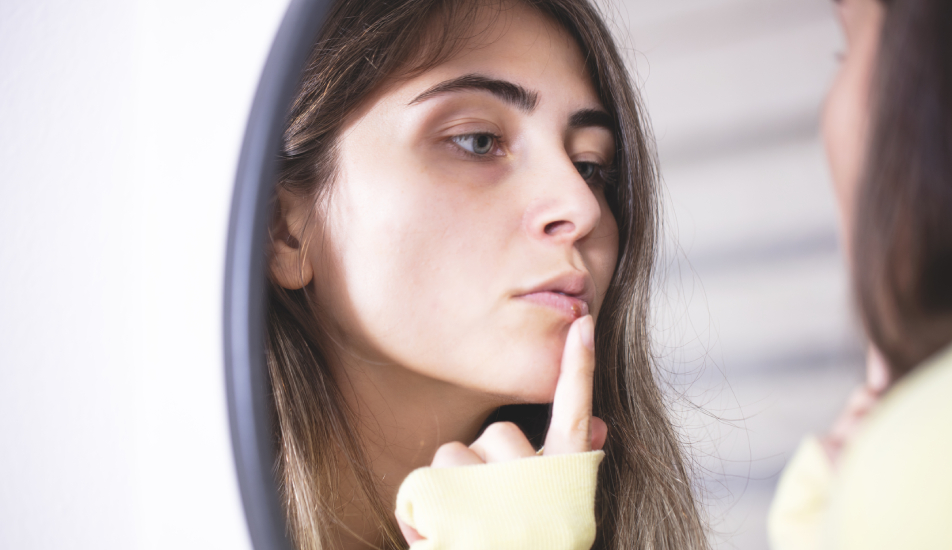
Cold Sore Causes
You may have heard the term ‘cold sore’ before but are a bit unsure exactly what they are. Or perhaps you’re all too familiar with that tell-tale tingly feeling but want to find out more about why it happens. Look no further – we’ve got you covered with the what, why, how, and when of all things cold sores!
What are cold sores?
Cold sores are small blisters that usually form on or around your lips. They can also sometimes form on the chin or in the nostrils. Most people experience some tingling or itching before the blisters of a cold sore develop. Cold sore blisters can be painful and weep before bursting and forming a crusty scab that eventually dries out and heals. Find out more about the stages of a cold sore here.
What causes cold sores?
Infection with HSV-1 is very common. It’s estimated that 2 in 3 people worldwide would test positive for HSV-1*, although not all of these people would have experienced an episode of cold sores. Most people become infected during childhood and continue to carry the virus throughout their life.
*Johnston C, Wald A. Epidemiology, clinical manifestations, and diagnosis of herpes simplex virus type 1 infection [June 2021]. In: Hirsch MS (Ed). UpToDate. Waltham, MA; 2022.
How do you get cold sores?
HSV-1 is quite contagious, meaning that it can spread easily from one person to another. You can catch the virus when you come into contact with a cold sore, saliva, or skin from a person with the HSV-1 virus. This can happen during direct contact such as kissing or touching, or by sharing contaminated items such as towels, toothbrushes, razors, cutlery, drink bottles, and glasses.
You are more likely to catch HSV-1 from someone when they have an active cold sore, especially in the early stages when the blister is forming. But it is important to remember that HSV-1 can spread between people even when there are no symptoms of infection.
The first time you get HSV-1 is what’s called the primary infection. Once the virus enters your body through the skin cells, it increases in number at the site of contact. The virus then travels into your nerves and sets up home in a bundle of nerve cells located near the side of your head. Although HSV-1 remains present, it becomes what is called a latent infection. This means that most of the time, it is not active and does not cause any symptoms. At certain times, however, the virus gets reactivated and travels back to the skin to cause cold sores. You can find more details about the different symptoms associated with primary vs recurrent infection here.
What triggers cold sores?
Most people’s first episode of cold sores occurs when they first get infected with HSV-1. After this first outbreak, the virus lies dormant or inactive in the nerve cells until it becomes reactivated. So, what triggers this reactivation and what causes cold sores to flare up?
Common reasons for cold sores to develop include:
- Illness – colds and flu or other feverish illnesses that affect your immune system
- Hormones – hormonal changes such as a menstrual period
- Environment – exposure to sunlight, wind, or cold air
- Stress – experiencing emotional, mental, or physical stress
- Fatigue – being tired and feeling run down
- Trauma – injury or damage at or near the site of primary infection
What can I do about cold sores?
So now that you understand a bit more about what causes cold sores on lips, you might be wondering what you can do when they pop up. Unfortunately, there is no cure once you have the HSV-1 infection, but there are some simple things that you can do to reduce the risk of spreading the virus and ways to help prevent outbreaks – learn more here.
The other good news is that if you do experience an outbreak, your cold sore symptoms can be treated. Discover how the triple-action formula of VIRASOLVE® Cold Sore Cream can help relieve the symptoms of an unsightly cold sore on the lip here.
Always read the label and follow the directions for use
Cold sore causes FAQs
No – many people who have primary HSV-1 infections do not experience symptoms or outbreaks of cold sores. It’s estimated that as many as 3 in 4 people who test positive for the virus have not had cold sores in the past.
It’s hard to say – how often cold sore outbreaks happen (and how bad they are) depends on each individual person. Still, you may start to identify certain patterns or triggers associated with your own outbreaks that can help you manage or prevent the symptoms.
While the common cold may sometimes trigger an outbreak of cold sores, their name is a little misleading – cold sores are actually caused by an infection with the herpes simplex virus type 1.
This may be the case for some people. Colds and flu and cold air or wind – all of which are usually more common in winter – may trigger a cold sore outbreak in some but not all people.
